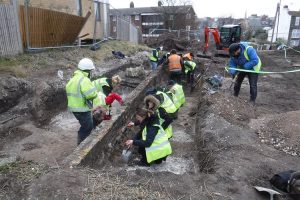Excavations at the construction site of a ticket office of Margate Caves, Kent, United Kingdom, unearthed remains of an Iron Age hillfort into which a 17th century chalk mine was cut.

The Margate Caves, also known as Vortigern’s Cavern, are a set of galleries formed by a chalk mine radiating out from a rectangular shaft. The chalk mine was probably worked between the late 17th and early 18th centuries. Archaeologists discovered a defensive ditch during their routine work. The structure was part of the hillfort’s defences, part of a wider encampment believed to have been a defensive position since pre-history through to the Napoleonic era. Among other finds are large quantities of Stone Age pottery, and huge postholes of Iron Age buildings dated by large amounts of Iron Age pottery. Experts believe the inhabitants of the hillfort were either slaughtered or forced to flee the area.

The Margate Caves were discovered in 1798 by a gardener. The house owner, had the caves opened and employed a local artist to create carvings and paint scenes on the walls. According to Paul Wilkinson, of SWAT Archaeology, the caves were used for storage, a wine cellar and as a grotto. The caves were opened in 1907 by a the vicar, who cleared and cut new shafts, eventually opening the caves to the public again after 1910. They were re-opened and closed a couple of times during the 20th century, and stood closed since 2004.

(after Kent Online)